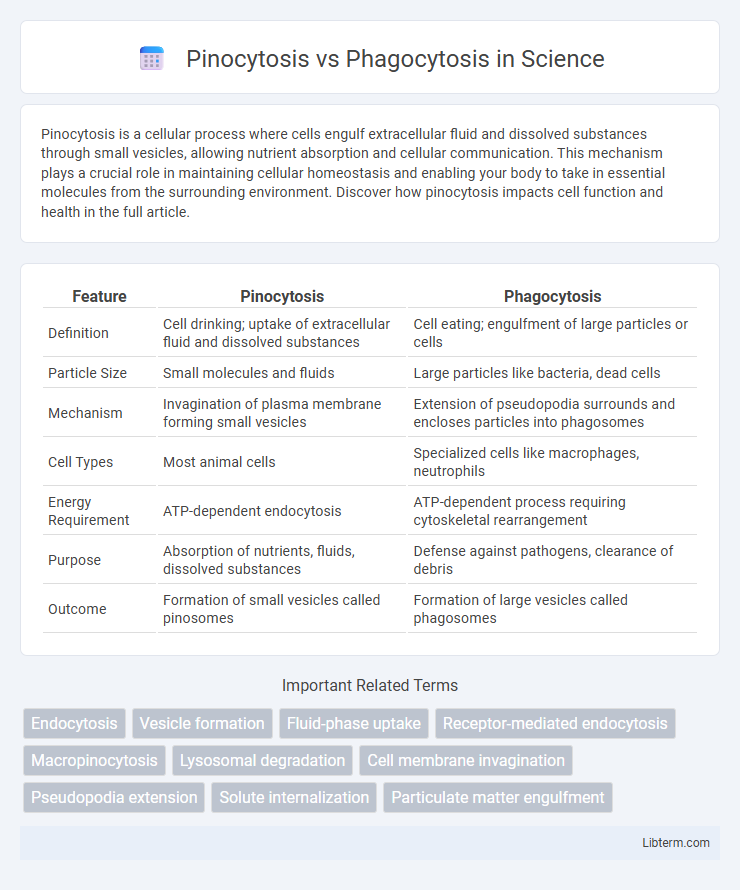Pinocytosis is a cellular process where cells engulf extracellular fluid and dissolved substances through small vesicles, allowing nutrient absorption and cellular communication. This mechanism plays a crucial role in maintaining cellular homeostasis and enabling your body to take in essential molecules from the surrounding environment. Discover how pinocytosis impacts cell function and health in the full article.
Table of Comparison
| Feature | Pinocytosis | Phagocytosis |
|---|---|---|
| Definition | Cell drinking; uptake of extracellular fluid and dissolved substances | Cell eating; engulfment of large particles or cells |
| Particle Size | Small molecules and fluids | Large particles like bacteria, dead cells |
| Mechanism | Invagination of plasma membrane forming small vesicles | Extension of pseudopodia surrounds and encloses particles into phagosomes |
| Cell Types | Most animal cells | Specialized cells like macrophages, neutrophils |
| Energy Requirement | ATP-dependent endocytosis | ATP-dependent process requiring cytoskeletal rearrangement |
| Purpose | Absorption of nutrients, fluids, dissolved substances | Defense against pathogens, clearance of debris |
| Outcome | Formation of small vesicles called pinosomes | Formation of large vesicles called phagosomes |
Introduction to Endocytosis
Endocytosis is a cellular process where the cell membrane engulfs external substances to bring them into the cell. Pinocytosis involves the ingestion of extracellular fluid and dissolved solutes, forming small vesicles, while phagocytosis targets larger particles such as debris or microorganisms, creating larger vesicles called phagosomes. Both mechanisms play vital roles in nutrient uptake, immune defense, and cellular homeostasis by regulating the internalization of materials.
Pinocytosis: Definition and Mechanism
Pinocytosis, a form of endocytosis, involves the non-specific uptake of extracellular fluid and dissolved solutes through small vesicles formed by the invagination of the plasma membrane. This cellular process enables cells to internalize nutrients, signaling molecules, and other essential fluids, utilizing actin filaments to assist vesicle formation and trafficking. Unlike phagocytosis, which targets large particles or microorganisms, pinocytosis operates continuously and consumes minute volumes of fluid without receptor specificity.
Phagocytosis: Definition and Mechanism
Phagocytosis is a cellular process where specialized cells, such as macrophages and neutrophils, engulf and digest large particles, including bacteria and cellular debris. This mechanism involves the extension of pseudopodia around the target, forming a phagosome that fuses with lysosomes to breakdown the engulfed material using hydrolytic enzymes. Phagocytosis plays a critical role in immune defense and tissue homeostasis by removing pathogens and apoptotic cells from tissues.
Key Differences Between Pinocytosis and Phagocytosis
Pinocytosis involves the ingestion of extracellular fluid and dissolved solutes through small vesicles, primarily functioning in nutrient absorption and cellular fluid regulation. Phagocytosis engulfs large particles such as pathogens or cellular debris via membrane extensions called pseudopodia, playing a critical role in immune defense and cleanup of dead cells. While pinocytosis is a non-specific process occurring continuously, phagocytosis is receptor-mediated and activated primarily in specialized cells like macrophages and neutrophils.
Cellular Functions of Pinocytosis
Pinocytosis is a form of endocytosis where cells ingest extracellular fluid and dissolved solutes, enabling nutrient uptake and membrane recycling critical for cellular homeostasis. Unlike phagocytosis, which engulfs large particles or pathogens, pinocytosis continuously regulates the cell's internal environment by absorbing small molecules nonspecifically. This process supports cellular metabolism and signal transduction by maintaining the balance of ions and macromolecules within the cytoplasm.
Biological Roles of Phagocytosis
Phagocytosis plays a critical role in the immune system by enabling the engulfment and destruction of pathogens, dead cells, and debris, thereby maintaining tissue homeostasis and defending against infections. Macrophages and neutrophils utilize phagocytosis to target and eliminate bacteria, viruses, and apoptotic cells, facilitating inflammation resolution and tissue repair. Unlike pinocytosis, which is a non-specific uptake of extracellular fluid, phagocytosis is a receptor-mediated process essential for innate immunity and antigen presentation to activate adaptive immune responses.
Examples of Pinocytosis in Living Organisms
Pinocytosis in living organisms is exemplified by endothelial cells lining blood vessels, which ingest extracellular fluid to sample nutrients and solutes, and by renal tubular cells actively absorbing dissolved substances to maintain homeostasis. Immune cells such as macrophages also utilize pinocytosis to continuously internalize small volumes of fluid containing antigens for immune surveillance. This process contrasts with phagocytosis, where larger particles like bacteria or cell debris are engulfed by specialized cells.
Examples of Phagocytosis in Immune Response
Phagocytosis plays a crucial role in the immune response by enabling macrophages to engulf and destroy pathogens like bacteria and cellular debris, facilitating infection control. Neutrophils, another type of phagocytic cell, rapidly target and digest invading microorganisms during acute inflammation. These processes are essential for maintaining tissue homeostasis and activating adaptive immunity by presenting antigens to lymphocytes.
Importance of Pinocytosis and Phagocytosis in Health
Pinocytosis plays a vital role in cellular nutrition by enabling cells to ingest extracellular fluids and dissolved nutrients, essential for maintaining cellular homeostasis. Phagocytosis is crucial for immune defense, allowing specialized cells like macrophages to engulf and destroy pathogens, cellular debris, and apoptotic cells, thus preventing infections and promoting tissue repair. Together, these processes are fundamental for immune system function, nutrient uptake, and overall cellular health.
Conclusion: Pinocytosis vs Phagocytosis
Pinocytosis involves the nonspecific uptake of extracellular fluids and dissolved solutes through small vesicles, whereas phagocytosis is the targeted ingestion of large particles such as cellular debris or pathogens by specialized cells like macrophages. Both processes are essential for cellular intake but differ fundamentally in mechanism, specificity, and function within immune response and nutrient acquisition. Understanding these distinctions aids in comprehending cellular behavior in health and disease contexts.
Pinocytosis Infographic

 libterm.com
libterm.com